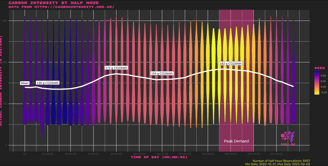
Why reducing peak power also means reducing carbon emissions
Peak power demand occurs across the UK at the same time every day. By reducing energy usage during peak demand, you're also reducing your carbon emissions. A lot.
PEAK DEMANDDECARBONISATIONDEMAND SIDE REDUCTIONDEMAND FLEXIBILITY SERVICE
Not all energy is created equal
Across the UK we have lots of ways of producing energy. Sometimes we can get it from renewable sources, like wind and solar. Sometimes we can't, and have to get it from non-renewable generators, like gas turbines and coal fired power stations. Thanks to the many live data sources describing how much of the energy on national grid comes from what source, there are many live dashboards available to understand what the fuel mix is like right now, and what it's been like historically. Kate Rose Morley has published exactly that kind of tool here. It's a clear and effective explainer, and much more effective for data exploration than the more simplistic National Grid equivalent dashboard here. However neither is designed to help with the question "Do the hours of peak energy demand on the grid regularly lead to more carbon emissions?"
Is peak demand more carbon intensive?
Peak Demand in the UK is when the grid experiences it's highest demand for energy. This happens between 5pm and 8pm in the United Kingdom, when people tend to return back from work, prepare dinner, and settle into an evening at home. As most people in the country are doing this at roughly the same time, this turns up the pressure on the electricity supply which needs to be delivered at that exact point in time. To work out how this tends to impact the countries carbon emissions we can use the historical carbon intensity data available from https://carbonintensity.org.uk/. Because CarbonIntensity.org.uk record the grams of carbon dioxide produced per kilowatt hour (kWh) every half hour, we can calculate the average (mean) for each half hour for every day ion the data set. As there are so many data points, we can also calculate the 'skew'. This tells us about the distribution of the data around the mean. Crucially it tells us if the chances are that any one half hour will tend to actually use slightly more than the average, or slightly less. So with that info we can work out if the grid tends to be more carbon intensive during peak hours.
By avoiding peak energy demand you will reduce your carbon footprint
It's clear that the most carbon intensive time to use energy is during the hours of peak demand on the grid 6pm to 8pm. Not only that, but because the data skews towards being more carbon intensive during those peak hours, it's more likely that you will use more carbon during those times. Conversely, when you use energy at the during the lowest demand on the grid, that energy is on average less carbon intensive and also skews towards lower carbon emissions.
So what does this mean for your home? It means that if you use electricity at 2 am then that energy is probably 25% more renewable than the energy you might use at 6pm. It also means that if you use energy at 8 am it's likely going to be 10% more carbon intensive than if you waited 4 hours and used energy at midday. Inthewash.co.uk suggest that most dishwashers in the UK use around 0.9 kWh per load. As the carbon intensity data is measured in grams per kWh this means that if you turned your dishwasher on at 6 pm you would probably be responsible for 163.8 grams of carbon (0.9 kWh x 182 gCO2 per kWh), but if you use your dishwashers timer feature to start at 2am you can reduce your carbon emissions by a quarter to 122.4!
ENGI.AI can help
ENGI.AI is a machine learning service, that can predict the energy use of your home. It learns how your home uses energy, and can tell you in advance how much energy you're likely to use tomorrow, and when you're going to use it. You can sign up to the alpha launch right now.


